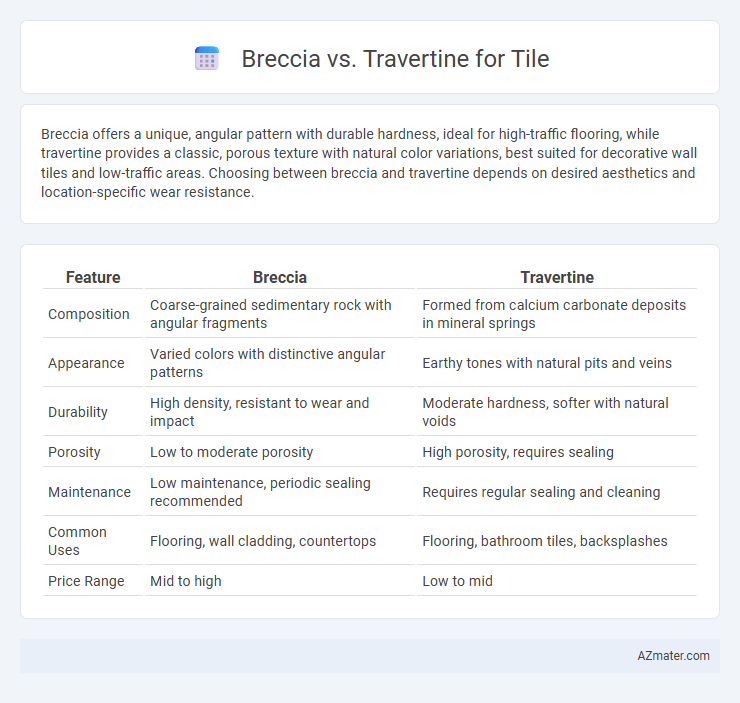Breccia offers a unique, angular pattern with durable hardness, ideal for high-traffic flooring, while travertine provides a classic, porous texture with natural color variations, best suited for decorative wall tiles and low-traffic areas. Choosing between breccia and travertine depends on desired aesthetics and location-specific wear resistance.
Table of Comparison
| Feature | Breccia | Travertine |
|---|---|---|
| Composition | Coarse-grained sedimentary rock with angular fragments | Formed from calcium carbonate deposits in mineral springs |
| Appearance | Varied colors with distinctive angular patterns | Earthy tones with natural pits and veins |
| Durability | High density, resistant to wear and impact | Moderate hardness, softer with natural voids |
| Porosity | Low to moderate porosity | High porosity, requires sealing |
| Maintenance | Low maintenance, periodic sealing recommended | Requires regular sealing and cleaning |
| Common Uses | Flooring, wall cladding, countertops | Flooring, bathroom tiles, backsplashes |
| Price Range | Mid to high | Low to mid |
Understanding Breccia and Travertine: An Overview
Breccia tiles showcase a striking appearance with angular fragments of varied colors cemented together, offering a unique, dramatic pattern ideal for feature walls and flooring. Travertine tiles exhibit a more uniform, porous texture formed from mineral deposits in hot springs, known for their warm, earthy tones and natural pitting that adds rustic charm and slip resistance. Both natural stones require sealing for durability and maintenance, but their distinct geological formations and aesthetic qualities influence their suitability for different interior design styles.
Formation and Geological Differences
Breccia forms from angular rock fragments cemented together through mechanical weathering and tectonic processes, creating a coarse texture with varied shapes and sizes. Travertine, a type of limestone, results from the precipitation of calcium carbonate in hot springs or limestone caves, featuring a smoother, banded appearance with porous cavities. The primary geological distinction lies in breccia's clastic sedimentary rock origin versus travertine's chemical sedimentary formation driven by mineral deposition in aqueous environments.
Appearance and Visual Characteristics
Breccia tiles feature a distinctive fragmented appearance with angular, multicolored mineral fragments set in a contrasting matrix, creating a dramatic and textured visual effect. Travertine tiles showcase a more uniform, earthy palette with natural pitted holes and smooth veins, offering a warm, rustic aesthetic often polished or honed for varied surface finishes. Both materials provide unique visual interest, with breccia emphasizing bold patterns and travertine highlighting subtle, natural elegance.
Durability and Hardness Comparison
Breccia and travertine tiles differ significantly in durability and hardness, with breccia exhibiting greater resistance to scratches and impacts due to its composition of angular gravel fragments bound by a cement-like matrix. Travertine, a form of limestone, is softer and more porous, making it more susceptible to wear, chipping, and staining without proper sealing and maintenance. Selecting breccia is ideal for high-traffic areas requiring robustness, while travertine suits spaces prioritizing aesthetic warmth despite its relatively lower hardness on the Mohs scale.
Maintenance and Cleaning Requirements
Breccia tiles require regular sealing to prevent staining due to their porous nature, with cleaning involving mild detergents and soft cloths to avoid surface damage. Travertine tiles also need sealing but are more prone to etching from acidic cleaners, so neutral pH cleaning solutions are essential for maintenance. Both materials benefit from prompt spill cleanup and periodic resealing to maintain durability and appearance.
Slip Resistance and Safety for Flooring
Breccia tiles typically exhibit a moderate slip resistance due to their naturally textured surface, making them suitable for areas requiring enhanced safety. Travertine tiles, often more porous and smoother, may require sealing treatments to improve slip resistance and prevent accidents in high-traffic or wet areas. Selecting Breccia or treated Travertine depends on specific flooring safety needs, with Breccia generally favored in environments prioritizing traction and slip prevention.
Cost Analysis: Breccia vs Travertine
Breccia tiles typically present a higher cost compared to travertine due to their unique fractured appearance and rarity, with prices ranging from $20 to $50 per square foot, while travertine averages around $15 to $30 per square foot. Installation costs can also vary, as breccia's irregular texture often requires more labor-intensive cutting and sealing processes, increasing total project expenses by approximately 10-15% over travertine. Factoring in maintenance, travertine demands frequent sealing but remains more budget-friendly overall, whereas breccia's durability reduces long-term repair costs despite its initial higher investment.
Ideal Applications for Each Stone
Breccia, characterized by its bold, fragmented patterns and high durability, is ideal for accent walls, fireplace surrounds, and flooring in high-traffic areas where a dramatic, luxurious appearance is desired. Travertine, known for its soft, porous texture and warm, neutral tones, excels in bathroom floors, backsplashes, and outdoor patios, offering slip resistance and a timeless, natural aesthetic. Both stones perform well indoors and outdoors, but Breccia's density suits heavy-use environments, while Travertine's natural pits provide added grip in wet conditions.
Environmental Impact and Sustainability
Breccia tiles, composed primarily of natural stone fragments bonded under pressure, offer a sustainable choice due to minimal processing and long-lasting durability that reduces replacement frequency. Travertine, formed from mineral deposits in natural springs, involves more intensive quarrying and processing, which can increase environmental impact; however, its natural formation and recyclability contribute positively to sustainability. Selecting between Breccia and Travertine for tile depends on weighing quarrying footprint against longevity and recyclability, with both stones providing eco-friendly options when sourced responsibly.
How to Choose Between Breccia and Travertine for Your Project
Choosing between Breccia and Travertine tiles depends on the aesthetic and durability requirements of your project. Breccia offers bold, dramatic veining with a polished finish ideal for statement areas, while Travertine provides a softer, classic look with natural pits and a matte or honed surface suited for rustic or traditional designs. Consider the location's foot traffic and maintenance needs, as Travertine is more porous and requires sealing, whereas Breccia tends to be harder and more resistant to staining.

Infographic: Breccia vs Travertine for Tile
 azmater.com
azmater.com